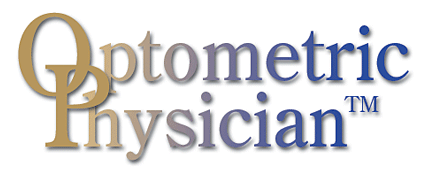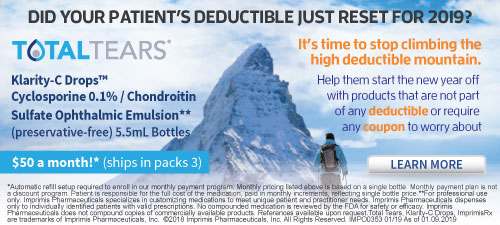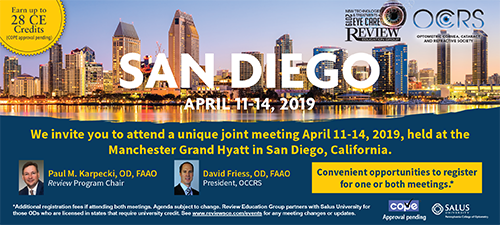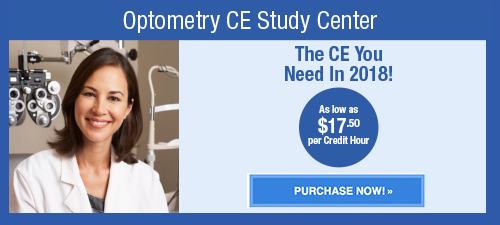
A
weekly e-journal by Art Epstein, OD, FAAO
Off the Cuff: An Inflection Point – VSP Sees the Future
If you haven’t heard, VSP Global just announced what will be the beginning of massive changes in the company’s structure and focus. Later this year, VSP will be opening three Eyeconic retail locations in Chicago. It will also be launching VSP Ventures to compete with the growth of equity capital practice consolidators. Though some VSP stalwarts will be angry while others camp in the ‘I-told-you-so’ mentality, the simple truth is that VSP sees the future of optometry more clearly than most of us do. What VSP sees is that optometry is changing—so rapidly that it’s hard for most of us to grasp what’s actually happening. Many ODs, our organizations and institutions, and even much of the eye care industry continues to tootle along as if its business as usual. Far from it. Five years from now, optometry will be unrecognizable in many ways. There will likely be more Eyeconic stores and VSP-owned “independent” practices than traditional VSP providers. So, what should you do—get mad a VSP? That would be pointless and counterproductive. A far better approach would be to do what VSP is doing: change. Don’t end up standing in the path of an avalanche, while you still have time to get out of the way.
|
|||||
 |
||
| Meibomian Gland Dysfunction and Dry Eye are Similar but Different, Based on a Population-Based Study (Hirado-Takushima Study) in Japan | ||||
A population-based cross-sectional study was conducted to evaluate the prevalence and risk factors of, and the relationship between, meibomian gland dysfunction (MGD) and dry eye (DE) in Japan. Participants filled in questionnaires regarding ocular symptoms, systemic diseases and lifestyle factors. Meibomian gland-related parameters and tear film-related parameters were evaluated. Risk factors for MGD and DE were analyzed with univariate and multivariate logistic regression. Age-specific prevalence of MGD and DE were estimated with a general additive model with degree-3 natural splines. The structural relation between MGD and DE was assessed by factor analysis with the principal components method and promax rotation.
A total of 356 residents of Takushima Island (133 males, 223 females) with a mean ±SD age of 55.5 ± 22.4 years (range, six to 96 years). The prevalence of MGD and DE was 32.9% and 33.4%, respectively, with a coexistence rate of 12.9%. The prevalence of MGD was associated with male sex (odds ratio [OR], 2.42), age (OR per decade increment,1.53) and oral intake of lipid-lowering agents (OR, 3.22). The prevalence of DE was associated with female sex (OR, 3.36), contact lens wear (OR, 2.84), conjunctivochalasis (OR, 2.57) and lid margin abnormalities (OR, 3.16). The age-specific prevalence of MGD and DE differed, and factor analysis for 16 parameters showed that MGD and DE had independent hidden sources (interfactor correlation, -0.017). Researchers concluded that MGD and DE were common in this population. Although their ocular symptoms were similar, the pathogenesis of MGD differed from that of DE. |
||||
SOURCE: Arita R, Mizoguchi T, Kawashima M, et al. Meibomian gland dysfunction and dry eye are similar, but different based on a population-based study (Hirado-Takushima study) in Japan. Am J Ophthalmol 2019; Mar 6. [Epub ahead of print]. |
||||
 |
||
| Effect of Gender and Procedure on Patient-reported Dry Eye Symptoms After Laser Vision Correction | ||||
This study evaluated factors associated with the change in dry eye symptoms following laser vision correction. This was a retrospective case series of 13,319 patients who underwent laser in situ keratomileusis (LASIK) or photorefractive keratectomy (PRK) between January 2013 and February 2016, and completed a preoperative and three-month-postoperative, patient-reported-outcome questionnaire.
In a multivariate linear regression model, women and contact lens wearers were associated with worse preoperative dry eye symptoms. Age was not significantly associated with preoperative dry eye symptoms. The change in dry eye symptoms preoperatively to postoperatively was affected by gender, procedure type and preoperative dry eye symptoms. Patients who underwent PRK were more likely to report an increase in dry eye after three months (coefficient: 3.99, 95% confidence interval (CI): 1.64 to 4.82, p<.001), and patients with worse preoperative dry eye were more likely to have improvement in symptoms after surgery (coefficient: -0.93, 95% CI: -0.97 to -0.90, p<.001). More women reported an increased level of symptoms three months after surgery than men (coefficient: 1.76, 95% CI: 0.68 to 2.84, p=.001). Preoperative dry eye symptoms, female gender and procedure type had a significant effect on preoperative to postoperative change in dry eye symptoms after laser vision correction. Age was not associated with dry eye symptoms in this population. |
||||
SOURCE: Schallhorn JM, Pelouskova M, Oldenburg C, et al. effect of gender and procedure on patient-reported dry eye symptoms after laser vision correction. J Refract Surg. 2019;35(3):161-168. |
||||
 |
||
| Wide-Field Choroidal Thickness in Myopes and Emmetropes | ||||
Investigators wrote that a paucity of knowledge exists regarding the normal in-vivo thickness of the choroid beyond the macula (~17°). In this study, the choroidal thickness of 27 healthy young adults was examined across the macular (the central 5 mm including the fovea, parafovea and perifovea) and extra-macular (a 5mm to 14mm annulus including the near-periphery and periphery) regions using wide-field optical coherence tomography, and compared between emmetropes (n=14) and myopes (n=13). The choroid progressively thinned beyond the parafovea (350µm ± 86µm) towards the periphery (264µm ± 44µm), and was thickest superiorly (355µm ± 76µm) and thinnest nasally (290 ± 79 µm). Choroidal thickness also varied with refractive error; myopes exhibited a thinner choroid than emmetropes in the macular region (311µm ± 88 µm vs. 383µm ± 66µm). However, this difference diminished towards the periphery (251µm ± 48µm vs. 277µm ± 37µm). Meridional variations in choroidal thickness were not different between myopes and emmetropes. Investigators reported that the choroid was thickest within the perifovea, thinned substantially towards the periphery, and exhibited the minimum and maximum peripheral thinning superiorly and nasally across a 55° region respectively. Choroidal thinning associated with myopia was more pronounced in the macular than extra-macular regions. |
||||
SOURCE: Hoseini-Yazdi H, Vincent SJ, Collins MJ, et al. Wide-field choroidal thickness in myopes and emmetropes. Sci Rep. 2019;9(1):3474. |
||||
 |
||
| News & Notes | ||||||||||||||||||||||
| Luneau Technology Debuts Eye Refract at Vision Expo East Luneau Technology will introduce the Eye Refract refraction system to the US eye care market at the 2019 Vision Expo East in New York City. The Visionix Eye Refract system is designed to meet the space, speed and consistency needs of the busy primary eye care practice. Eye Refract combines a patented Dual Hartmann-Shack Aberrometer with a digital phoropter as a way to provide high-quality automated wavefront refraction measurements with intuitive subjective refinements. In addition, the typical two-step refraction process to be consolidated into one. Autorefraction and subjective refinement can be completed in the pre-test room on a single instrument in just three minutes. Visionix developed an intuitive algorithm based on standard subjective bracketing techniques for a dynamic refraction system. Luneau Technology manufactures and distributes products under the Briot, Weco and Visionix brands. Luneau Technology will be offering demonstrations of the Eye Refract at booth# LP4445 during Vision Expo East. Learn more. |
||||||||||||||||||||||
| Soccer All Star Eskandarian to Speak at 28th Annual NORA Conference Two-time Major League Soccer All-Star Alecko Eskandarian will be the keynote speaker at the Neuro-Optometric Rehabilitation Association, International (NORA) 28th annual General Conference (Sept. 21-22) at the Embassy Suites by Hilton Scottsdale Resorts, Scottsdale, Ariz. Eskandarian, who now serves as senior manager, player relations and competition for the MLS, played in 125 games over the course of a seven-year MLS career for D.C. United, Toronto FC, Real Salt Lake, Chivas USA and the Los Angeles Galaxy. He also served as an assistant coach for the New York Cosmos and Philadelphia Union prior to his role at MLS. During his career, Eskandarian suffered four concussions, and experienced a variety of severe physical, mental and visual symptoms. He continued to play until 2009, when an opposing defender inadvertently cleared the ball into his face with such force it broke his nose and gave him his fourth concussion. He officially retired as a player in 2010. Since then, Eskandarian has been sharing his story about his concussions, and struggles with treatment and rehabilitation, and he continues to be an advocate for greater concussion awareness education. Learn more. |
||||||||||||||||||||||
| Clinical Trial: Re-Treatment with Single TearCare Treatment Continues to Provide Relief for DED Patients
A new, single center, prospective clinical study published in the January issue of Clinical Ophthalmology provides preliminary evidence that re-treatment with the Sight Sciences TearCare System is a safe and effective treatment for dry eye disease. The system is indicated for use in meibomian gland dysfunction, dry eye and blepharitis, but is not yet cleared by FDA for the treatment of the signs and symptoms of dry eye disease. A large, prospective, multi-center, randomized controlled trial will begin enrolling in the first quarter of 2019. In this continuation of the initial six-month, single center, pilot clinical trial published in 2017, 12 patients were re-treated after the six-month follow-up, and continued to experience a significant improvement in all dry eye signs (tear breakup time, corneal and conjunctival staining, and meibomian gland scores) and symptoms (SPEED, OSDI and SANDE) through 12 months. Read more. |
||||||||||||||||||||||
|
||||||||||||||||||||||
|
||||||||||||||||||||||
|
Optometric Physician™ (OP) newsletter is owned and published by Dr. Arthur Epstein. It is distributed by the Review Group, a Division of Jobson Medical Information LLC (JMI), 11 Campus Boulevard, Newtown Square, PA 19073. HOW TO ADVERTISE |





